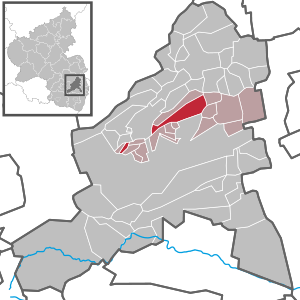Weisenheim am Berg
| coat of arms | Germany map | |
|---|---|---|

|
Coordinates: 49 ° 31 ' N , 8 ° 9' E |
|
| Basic data | ||
| State : | Rhineland-Palatinate | |
| County : | Bad Dürkheim | |
| Association municipality : | Freinsheim | |
| Height : | 230 m above sea level NHN | |
| Area : | 9.2 km 2 | |
| Residents: | 1699 (Dec. 31, 2019) | |
| Population density : | 185 inhabitants per km 2 | |
| Postal code : | 67273 | |
| Area code : | 06353 | |
| License plate : | DÜW | |
| Community key : | 07 3 32 049 | |
| LOCODE : | DE 6CL | |
| Association administration address: | Bahnhofstrasse 12 67251 Freinsheim |
|
| Website : | ||
| Local Mayor : | Joachim Udo Schleweis ( CDU ) | |
| Location of the local community Weisenheim am Berg in the Bad Dürkheim district | ||
Weisenheim am Berg , in Palatinate " Weisrem " (or to make it clear that weisenheim am Sand is not meant: " Weisemberg "), is a municipality in the Bad Dürkheim district in Rhineland-Palatinate . It belongs to the Freinsheim Association .
geography
The community itself is on the edge of Haard ; the west of the district protrudes into the Palatinate Forest and belongs to its sub-area Leininger Sporn . 55 percent of the municipal area is forested. To the south, Bad Durkheim , in the West Altleiningen , in the north Bobenheim am Berg and east is Herxheim am Berg .
The Krumbach valley , which is traversed by the eponymous brook, is located on the forest boundary ; The Ungeheuersee is also located in this area . The Mittelberg and the Kühberg also extend in this area . Further to the west there is also an exclave belonging to Weisenheim, which is bordered by the Isenach in the south .
history
The first documentary mention of the place was in the year 771 in the Lorsch Codex . During the time of the tribal duchies, the place was in the Duchy of Franconia . Later it belonged to Leiningen-Dagsburg until the end of the 18th century .
From 1798 to 1814, when the Palatinate was part of the French Republic (until 1804) and then part of the Napoleonic Empire , Weissenheim am Sand - as it was spelled at the time - was incorporated into the Canton of Dürkheim and had its own Mairie . In 1815 the place had 650 inhabitants. In the same year the place was initially added to Austria . A year later he moved to the Kingdom of Bavaria . From 1818 to 1862 the community was part of the Landkommissariat Neustadt , which was then converted into a district office.
In 1902 the place changed to the district office of Dürkheim , before this was reintegrated into its Neustadt counterpart in 1931. From 1939 the place was part of the district of Neustadt . After the Second World War , the municipality within the French occupation zone became part of the Palatinate administrative district in the then newly formed state of Rhineland-Palatinate. In the course of the first Rhineland-Palatinate administrative reform , the place changed on June 7, 1969 to the newly created district of Bad Dürkheim . Three years later it was assigned to the also newly formed community of Freinsheim .
religion
There was a synagogue on site , which was used until 1909. In the village itself there are two stumbling blocks that remind of two Jewish fellow citizens who were deported in 1940.
politics
Municipal council
The municipal council in Weisenheim consists of 16 council members who were elected in a personalized proportional representation in the local elections on May 26, 2019 , and the honorary local mayor as chairman.
The distribution of seats in the municipal council:
| choice | SPD | CDU | FDP | GREEN | BfW | total |
|---|---|---|---|---|---|---|
| 2019 | 5 | 7th | - | 2 | 2 | 16 seats |
| 2014 | 4th | 8th | - | 1 | 3 | 16 seats |
| 2009 | 6th | 9 | 1 | - | - | 16 seats |
| 2004 | 6th | 9 | 1 | - | - | 16 seats |
- BfW = Citizens for Weisenheim am Berg e. V.
mayor
Local mayor is Joachim Udo Schleweis (CDU). In the direct election on May 26, 2019, he was confirmed in his office with 57.90% of the votes.
coat of arms
|
Blazon : "Divided by silver and black, above the intertwined black capital letters WAB, below a six-pointed golden star, each accompanied by a silver rose with a golden lug ."
Approval: April 14, 1984, district government , Neustadt an der Weinstrasse |
|
| Foundation of the coat of arms: Weisenheim originally used a joint seal with Bobenheim am Berg and Kleinkarlbach , documented as of 1519 (LA Speyer, D 24 No. 378). It was not until 1764 that a Weisenheim court seal was found, which was modeled on the coat of arms, which had long been used under customary law and was only approved in 1984. It shows the letters WAB = Weisenheim am Berg in ligature and in the lower half of the shield probably the judgment star. |
Community partnerships
The community maintains partnerships with Plaus ( South Tyrol , Italy), St. Gengoux le National ( Mâcon , France) and Niederdorla ( Thuringia ).
Culture and sights
Cultural monuments
There are a total of 25 objects on site that are listed , including the building of the former synagogue and the Protestant church , formerly St. John and Paul . The latter is the oldest building in the municipality and has medieval paintings.
nature
In the district of Weisenheim am Berg there are a total of eight natural monuments , including the Ungeheuersee, which is surrounded by mixed forest.
Regular events
- On the first weekend in May, the wine hike takes place in the nearby hallway.
- On the long weekend around Ascension Day, Weisenheim's largest regular event is the traditional partnership, wine and local festival.
- Every year on the penultimate weekend in August, the Dorfkerwe & Winzertafel , a wine festival, is celebrated.
- On the Sunday before the day of national mourning , the Stutzen Festival takes place, where traditionally the new citizens are "clipped", that is, naturalized.
Economy and Infrastructure
economy
Weisenheim am Berg is a wine-growing town and as such part of the Palatinate wine-growing region . On site are the single vineyards of Mandelgarten , Sonnenberg and Vogelsang . There is a branch of VR Bank Mittelhaardt on site .
traffic
The federal highway 271 runs to the east and leads to the federal highway 6 in the north . In nearby Herxheim am Berg there is a stop of the Palatinate Northern Railway . From Bad Dürkheim the Rhein-Haardtbahn runs to Ludwigshafen am Rhein and Mannheim . Weisenheim am Berg is in the tariff area of the Rhein-Neckar transport association .
education
In Weisenheim there is a day-care center as well as a primary and secondary school plus .
tourism
The German Wine Route cycle path runs through the municipality . The Weisenheimer Hütte at the Ungeheuersee , operated by the Palatinate Forest Association , is located on the forest boundary , where catering takes place.
Personalities
Honorary citizen
- Otmar Fischer (* 1934), retired Protestant pastor, former local mayor and dialect preacher
- Georg Blaul (* 1950), local mayor
Sons and daughters of the church
- Otto Georgens (* 1950), auxiliary bishop in the Speyer diocese
People who worked on site
- Karl Gayer (1822–1907), forest scientist, was a district forester in Weisenheim am Berg from 1851 to 1855.
- Irmtraud Heym , holder of the Federal Cross of Merit
- Hieronymus Hofer (1815–1890), Protestant clergyman, social reformer, pastor of Weisenheim from 1844 to 1859
- Ferdinand Kolberg (* 1941), recipient of the Federal Cross of Merit
- Johann Georg Lehmann (1797–1876), pastor and historian, held the Protestant pastoral position in Weisenheim am Berg from 1828.
- Theo Rörig (* 1940), sculptor, designed the sanctuary of the Catholic Church in Weisenheim am Berg.
literature
- Literature about Weisenheim am Berg in the Rhineland-Palatinate State Bibliography
Web links
Individual evidence
- ↑ State Statistical Office of Rhineland-Palatinate - population status 2019, districts, communities, association communities ( help on this ).
- ↑ Minst, Karl Josef [transl.]: Lorscher Codex (Volume 4), Certificate 1140 March 17, 771 - Reg. 590. In: Heidelberg historical stocks - digital. Heidelberg University Library, p. 128 , accessed on January 20, 2016 .
- ^ Regional Returning Officer Rhineland-Palatinate: Local elections 2019, city and municipal council elections
- ^ The Regional Returning Officer RLP: direct elections 2019. see Freinsheim, Verbandsgemeinde, seventh line of results. Retrieved October 16, 2019 .
- ^ Karl-Heinz Debus: The great book of arms of the Palatinate . W. Gräber, Neustadt an der Weinstrasse 1988, ISBN 3-9801574-2-3 , p. 50 .














